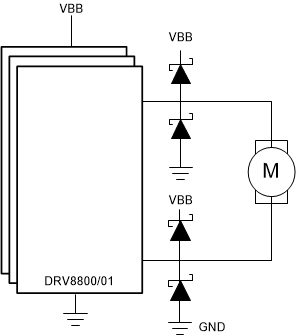SLVS855K July 2008 – March 2021 DRV8800 , DRV8801
PRODUCTION DATA
- 1 Features
- 2 Applications
- 3 Description
- 4 Revision History
- 5 Pin Configuration and Functions
- 6 Specifications
- 7 Parameter Measurement Information
- 8 Detailed Description
- 9 Application and Implementation
- 10Power Supply Recommendations
- 11Layout
- 12Device and Documentation Support
- 13Mechanical, Packaging, and Orderable Information
Package Options
Mechanical Data (Package|Pins)
Thermal pad, mechanical data (Package|Pins)
Orderable Information
9.3.4.2 Recirculation Current Handling
During recirculation, it is not possible to synchronize all devices connected in parallel so that the current is equally distributed. Also, during the asynchronous portion of the current decay, the body diode with the lowest forward voltage will start conducting and sink all of the current. Said body diode is not meant to handle the new increased current capacity and will be severely affected if allowed to sink current of said magnitude.
In order to assure proper operation when devices are connected in parallel, it is imperative that external schottky diodes be used. These schottky diodes will conduct during the asynchronous portion of the recirculation mode and will sink the inductive load current until the respective FET switches are brought online.
Schottky diodes should be connected as shown in Figure 9-10.
 Figure 9-10 Schottky Diodes Connection
Figure 9-10 Schottky Diodes Connection